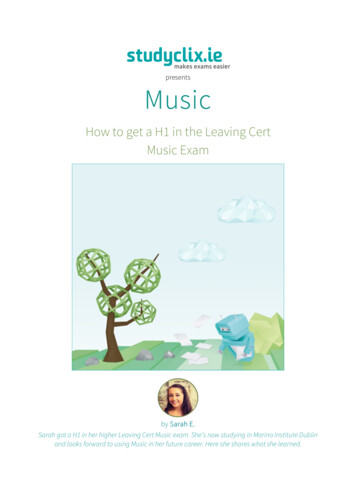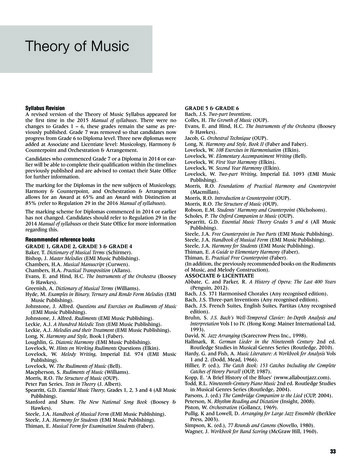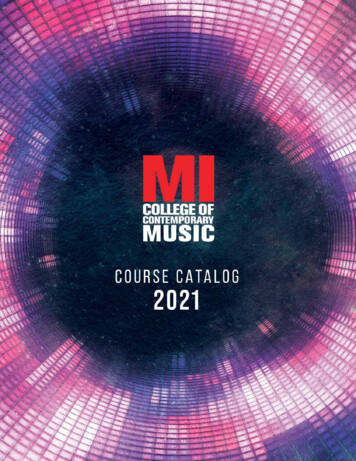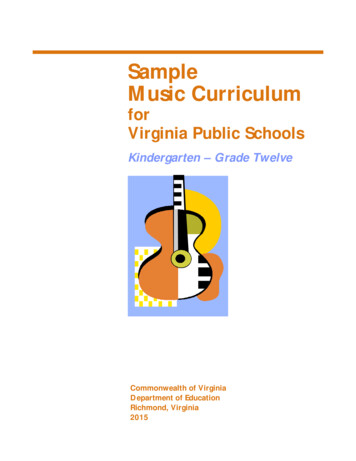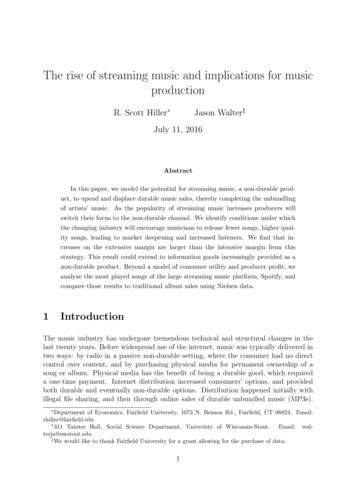
Transcription
Music forEvery ChildSFCM · Ann and Gordon Getty Foundationa special report for parents,educators, communityorganizers, policy-makersand citizens of the worldAnn and Gordon Getty FoundationMusic for Every Child1
Our Mission o ensure that every child in theTUS has access to a quality musiceducation.Executive SummaryMusic-making is an essential partof a child’s growthIt shapes our minds, develops our brains,unites our communities, and brings us joy.Music-making is fundamental to ourhumanity. The oldest known artifacts inhistory, dating back 40,000 years, includemusical instruments. Music is central to howbabies learn to communicate because theyrespond meaningfully to prosody — rhythmand tone — well before they understandspoken words.Neuroscientists, educators and psychologists have all provided compelling evidencethat music training can improve attention,memory, language, social skills, creativityand executive function—that set of mentalskills that helps us get things done.Musicians show greater connectivity inthe brain as well as other structural andfunctional differences compared withnon-musicians.Music programs pay for themselves byensuring better attendance in school andhigher graduation rates. Students whohave music training as an integral part oftheir overall education are better equippedto contribute to the workforce, especiallybecause theirs is a future where innovation will be the key to finding solutions forincreasingly complex problems.Yet public school music programs are beingcut across the United States. These cutsdisproportionately affect under-privilegedstudents because these kids show the biggest gains in academic success when givenaccess to public music programs. Evenlimited music training can improve readingand language skills, particularly for thosewho struggle or have learning disabilities.This paper will describe the primacy ofmusic in our culture, review the effect ofmusic education on children in PreK-12schools, and make the case for music programs in every school.Music training can enhance attention, memory, language, socialskills, creativity and executive function — the skills that help us getthings done.
ContentsMusic is fundamental to who we are .4Section 1: Music-making builds brainsShaping brain development.5SIDEBAR: Music training improves language ability .5Amplifying development in toddlers, children, and teens.6SIDEBAR: How the brain develops.7Boosting neuroplasticity.8SIDEBAR: Musicians are better at multitasking.8SIDEBAR: Musicians extract more meaning from sound.9SIDEBAR: Music training coordinates left & right cerebral hemispheres. 10SIDEBAR: Musicians’ brains become more efficient. 11Boosting test scores and IQ. 11CASE STUDY:YOLA at HOLA proves music programs benefit underprivileged kids. 13Enhancing performance across the board . 15Section 2: Music-making builds characterImproving social skills. 17Building character. 18Motivating people, even through difficult periods. 20CASE STUDY:Harmony Project encourages youth to stay in school. 21Boosting creativity. 22Section 3: Music-making builds communityBenefiting the whole community. 24Delivering a strong return on investment. 25Conclusions. 27Call to Action . 28About the Author. 29Acknowledgements. 30Glossary. 31References. 33Endnotes. 37Note: All scientific terms are shown in italics and defined in the Glossary at the back. 2020 by San Francisco Conservatory of Music. Please feel free to copy and redistributethis material in any medium or format, acknowledging authorship and copyright to theSan Francisco Conservatory of Music and the studies upon which it is based.Version 1.0 published August 2020“The theory of relativity occurred to me by intuition and music isthe driving force behind this intuition. My parents had me study theviolin from the time I was six. My new discovery is the result of musicalperception.”— Albert Einstein
Music is fundamental to who we areThe discovery of man-made musical instruments dating back as far as 40,000 yearsindicates that music has been a part of ourhistory for as long as we can measure.guage and music support communication.Both play distinct roles in our evolution asa species, our development as individuals,and our capacity to build communities.Just like the discovery of fire, music profoundly increased the potential of ourspecies.Given how important communicationskills are in the workforce, interventionsthat improve speech and language processing are highly valuable, particularly inpopulations where traditional methods ofteaching these skills have fallen short.Fire helped our ancestors prepare bettermeals with less effort and gave themmore leisure time. Music helped them usethat extra time to exchange ideas, gaina deeper understanding of themselvesand others, teach their children, and forgerelationships.Music unlocks a child’s potential byenhancing the development of fundamental skills required in languagecommunication such as auditory process-Both music and language play distinct roles inour evolution as a species, our development asindividuals, and our capacity to build communities.Did music give early humans advantagesthat Neanderthals lacked? Without music,would our species have evolved with theability to live in large groups — a feat thatno other primate has mastered?Through language, we share, debate andrefine our ideas. In fact, how we think isframed by the languages that we speak.Much of the work in neuroscience demonstrates that music and language processingoverlap — both in neuroanatomy and incognitive skills.There are also many differences. Howeverthe underlying reality is that both lan-SFCM · Ann and Gordon Getty Foundationing, comprehension of speech, speechproduction, abstract thinking, and emotional understanding.Music is a tool that has shaped humandevelopment through millenia. In ourmodern age, music gives educators a modethrough which they can reach studentswho are otherwise difficult to engage andimprove their communication skills viamultiple different circuits. It also providesthe neuroanatomical and functional foundation on which our complex minds arebuilt. A child’s brain is especially malleable,and music not only enhances existingconnections but also creates new ones.Music for Every Child4
Section 1: Music-making builds brainsShaping braindevelopmentBuilding babies’ brainsEven before a fetus has left the womb, music is a part of its life.Newborn babies recognize melodies played in utero and showmeasurable brain changes in response to them.1 There is evenevidence that playing music in the neonatal intensive care unitaccelerates the functional development of preterm baby brains,making them more similar to the brains of babies born full-term.2While the brain is undergoing rapid growth in the first year —tripling in size — exposure to meaningful sound can have alifelong effect on brain development and cognitive functions likelanguage processing and social interactions.In fact, a recent study3 has shown that infants as young as ninemonths old can benefit in measurable ways from a musical intervention. (See sidebar “Music training improves language ability”for more details.)For as long as we have recorded human history, and likely longbefore then, humans have used music to communicate with theirbabies — singing lullabies to lull them to sleep or playing songsto entertain and teach them. Only recent advances in technology give parents the option to shift from active participation inmusic-making to passive listening through a device.Are there consequences? Are there any measurable benefits to livesinging and music-making rather than listening to a recording?Indeed there are, and these benefits appear as early as six monthsof age.Beyond language learning, participating in music-making alsohelps infants make sense of social cues.4 Six month old babiesexposed to active participatory music classes could communicatebetter using gestures and other social behavior than their control group counterparts after only half a year of training. Makingmusic helps babies interact with others even before languageabilities come online.Early music education for infants has real developmental benefits.SFCM · Ann and Gordon Getty FoundationMusic trainingimproveslanguage abilityFor some time, early childhood educators have been aware that musictraining improves a child’s languageability. In 2016, researchers ChristinaZhao and Patricia Kuhl proved thata musical intervention of teachingbabies waltz time improved theirability to learn speech.The babies took part in 12 sessions ofabout 15 minutes over four weeks. Sessions were modeled on typical infantmusic classes. Caregivers synchronizedtheir baby’s movements with themusic. Sometimes they used percussive toys like shakers, while other timesthey just bounced to the music.Researchers found the “music classbabies,” who were bounced or whosemovements were in sync with themusic, showed enhanced neuralresponses to violations of temporalstructure. In other words, they noticedwhen something didn’t sound “right.”This skill underlies our ability to recognize the temporal aspects of speech,like syllables belonging to the sameword.What’s more, the babies’ new skill bledover to speech perception. The musicclasses helped babies develop thefoundations that underlie languageskills.Source: Zhao, T.C. and Kuhl, P.K. (2016).Musical intervention enhances infants’neural processing of temporal structurein music and speech. Proceedings of theNational Academy of Sciences, 113(19),5212-5217.Music for Every Child5
Section 1: Music-making builds brainsAmplifying development intoddlers, children, and teensThe powerful effects of music training continue through toddlerhood, childhood andadolescence.Music-making can help toddlers find ways to self-soothe. Any parent whose child sings inthe crib has likely noticed this effect. Toddlers also feel more attached to their caregiverswhen sung to, and they build self-esteem and confidence by learning to participate ingroup music-making.Music helps children understand different emotions and recognize these emotions inothers. It’s the musical quality of infant-directed speech that provides babies with theinformation they need to understand the emotional content of what is being communicated.5 Kids as young as four can recognize emotions such as happiness, anger, sadnessand fear in music.6Children who make music with others also learn to cooperate since this activity involvestaking turns, listening and replying.Music training is particularly effective in driving theplasticity of white matter pathways between andwithin brain hemispheres.When it comes to brain development, music education that begins in childhood andcontinues during adolescence can amplify developmental changes. (See sidebar on p. 7“How the brain develops,” for an explanation of brain development through childhood.)Music training is particularly effective in driving the plasticity of white matter pathwaysbetween brain hemispheres as in the case of the corpus callosum, the broad band of nervefibers that joins the two cerebral hemispheres.Music training is equally effective at driving plasticity within the hemispheres as seen inthe arcuate fasciculus, the white matter pathway connecting the temporal lobe to the frontallobe.There does seem to be an important sensitive period in childhood, somewhere betweensix and eight years of age, when these changes are most likely to happen and as neuroscientist Christopher J. Steele and others note, “serve as a scaffold on which later trainingcontinues to build.”9SFCM · Ann and Gordon Getty FoundationMusic for Every Child6
Section 1: Music-making builds brainsIn high school, the social effects of music programs seem to bethe most helpful. Music helps anchor teens who are particularlyvulnerable to poor choices such as substance abuse, delinquencyand absenteeism. (See “Music-making improves social skills” onp. 17.)Yet students who have had earlier musical training will show evengreater benefits as their brains are better able to accommodateand take advantage of training later in life.Music training impacts development from the womb through toadulthood. The earlier that children start music education, themore they’ll benefit throughout their lives.How the braindevelopsThe early years of childhood have anoutsize influence on brain development. By age six, children’s brains havereached about 90 percent of the sizethey will be as adults.7But there are still many changes thatoccur in the process after age six.2137One is synaptic pruning — the purgingof unnecessary synapses. Pruning is asign of learning, as brain cells establishmeaningful connections with eachother.5468119101. prefrontal cortex: supports executive functions2. premotor cortex: involved in controlling motor function3. primary motor cortex: music training enlarges regions that controlmuscles involved in playing4. primary somatosensory cortex: receives sensory input from body; areasdevoted to parts of the body used by skilled musicians grow larger withtraining5. parietal association area: combines information across senses andmodulates attentional focus6. visual cortex: processes visual information7. Broca’s area: involved in speech production8. auditory cortex and Wernicke’s area: processes of auditory informationand speech comprehensionAnother change is myelination, inwhich axons, the highways alongwhich electrical impulses flow,become enveloped in a fatty sheath.This speeds up neurons communicating with each other. The fat in myelinlooks white, which is why these fibertracts are called white matter. The cellbodies, dendrites (the receiving endsof neurons) and glial or support cellsmake up gray matter.One of the last parts of the brain tobecome fully myelinated is the prefrontal cortex, the region implicatedin planning actions, decision-making,and social behaviour.That’s why adults tend to show betterjudgement, reasoning, and emotionalregulation than adolescents.89. temporal lobe: contains hippocampus and amygdala, long-termmemory and emotional modulation10. cerebellum: involved in fine motor coordination and other functions11. corpus callosum: fiber tract joining the left and right hemispheresSFCM · Ann and Gordon Getty FoundationMusic for Every Child7
Section 1: Music-making builds brainsBoosting neuroplasticityDramatic brain changesMusicians are betterat multitaskingMaking music is an all-encompassingexperience that requires doing manycomplex tasks at once:Our nervous system is remarkably malleable. This neuroplasticityallows experience to mold us. Our past leaves indelible marks onhow our neurons are shaped, how they connect with each other,and the types of signals that they send. listeningNeuroplasticity even affects the support cells that provide ourworkhorse neurons with the energy, nutrients and building blocksthey need to do their important jobs. coordinating many different bodypartsThere is no question that musicians show structural and functionaldifferences in neuroanatomy compared with non-musicians.10Whether these differences are learned or innate is an oft-posedquestion. Yet the evidence that music training shapes brains inobservable ways is unequivocal.In fact, the musician’s brain is the poster-child for neuroplasticity.11What’s more, these differences often track the extent of musicaltraining. That is, the more training a person has engaged in, thegreater the changes.There are a few general principles that apply to the changes wesee with musical training: imagining creating executing complex movements adapting to changingcircumstances.Humans are generally not very good atmultitasking. Our brains aren’t wellequipped to focus on many things atonce, even though our modern livesdemand it.Music-making prepares us for exactlythis type of work. Musicians tend toshow better working memory andbetter performance on tasks of executive function that require rapid shifts ofattention. The timing of training during development affects boththe extent and type of differences between musicians andnon-musicians. At first, training affects brain regions and circuits that areclosely tied to the specific functions being trained. That is, auditory regions involved in listening and motor regions involvedin playing are the first to demonstrate changes. With moretraining, skills transfer to more general functional improvementin domains such as executive function and working memory. Brain changes reflect the particulars of the training, includinggenres (free improvisation vs interpretation of composed musicfor example), instrument, training methods, and so on.SFCM · Ann and Gordon Getty FoundationMusic for Every Child8
Section 1: Music-making builds brainsMusic training is also used to study neuroplasticity because of how quickly changes can beobserved. In as few as five days, study participants who learned an exercise on the pianoshowed expansions in the cortical representation or “brain map” for their finger muscles.12In line with this idea, there is an anatomical landmark in the motor cortex called theomega sign, where the fingers and hand are represented. In pianists, the omega sign islarger in the left hemisphere, which controls the right hand that plays the melody. Instring players, it’s larger on the right, corresponding to the precise movements requiredby the left hand in these musicians.Musical training not only accelerates braindevelopment, but also produces long-lastingchanges even in the mature adult brain.It’s not just size that matters: These changes translate directly into better fine motor skillsthat are apparent even in non-musical tasks. Children with instrumental music trainingare more dexterous than their non-musical counterparts, even with as few as two yearsof training.13Other regions involved in auditory processing such as Heschl’s gyrus, or the primaryauditory cortex, Broca’s area, known for its role in speech production, and the rest of thesurrounding inferior frontal gyrus have been shown to be larger in musicians. It has beenfound to be more pronounced in those whose training started earlier in childhood andthose who reported practicing with greater intensity.14Musicians extract more meaning from soundNeuroscientists can measure how responsive brain cellsare to certain stimuli using an electroencephalogram orEEG. This tool involves placing electrodes near the scalpand measuring small but distinctive electrical changesrelated to underlying neural activity.When trained musicians are listening to a series of tonesinterrupted by a slightly different tone, an MMN responseoccurs, even if they are not playing close attention.15When these changes occur after the experimenter hasdone something specific, like playing a tone, we call themevent-related potentials (ERPs).Musicians show MMN for tones mistimed by as little as 20milliseconds, while non-musicians listen for twice as longbefore they register the response.16 That means that musicians’ brains can detect differences that non-musicianscannot hear.One such ERP is called the mismatch negativity or MMN.The MMN is interesting because it’s pre-attentive: Scientistscan observe it before the conscious mind has registeredthe event that triggered it.Interestingly, these findings do not mean that musicians’ears are more finely tuned. Rather, their brains find moremeaning in the signal, even before their conscious mindsrecognize it.SFCM · Ann and Gordon Getty FoundationMusic for Every Child9
Section 1: Music-making builds brainsThe breadth of cognitive, emotional and motor skills thatmusic-making demands is mirrored by the sheer magnitude ofways in which brains are changed with musical training. That’swhy music-making and its effects on the brain are so interestingto neuroscientists mapping how experience shapes our centralnervous system.What other features of music training make it such an effectivetool in shaping the brain?Music requires integrating information across sensory and motordomains, and involves attention, creativity, memory and emotional regulation.20 It’s also highly rewarding, which is anotherdriver of plasticity.21The act of integration that music demands combined with itsrewards make it a powerful way to shape the brain. The nextquestion is whether these changes translate into advantages thatextend beyond making music.Even for students with no aspirations to become professionalmusicians, do the effects of musical training transfer to superiorskills in other domains? That is, does a bigger corpus callosum oromega sign proffer any benefits beyond the ability to play a musical instrument?Music trainingsynchronizes leftand right cerebralhemispheresRecently, a group of Finnish scientists found that brain activation inmusicians is more symmetrical thanin non-musicians when listeningto music. The same effect was seenwhether they were listening to progressive rock, Argentinian tangos, orStravinsky.17This symmetry appears to be directlyrelated to music training, as keyboardists, who engage in more bimanualcoordination, showed larger effectsthan string players, for example.Across all musicians, the corpus callosum, the band of white matter joiningthe two brain hemispheres, was largerthan in non-musicians. This last findingreplicates previous work showing thatmusic training leads to more structuralconnectivity between the hemispheres,18 particularly if students wereexposed to training before age seven.The corpus callosum is not the onlywhite matter tract that differentiatesmusicians from non-musicians. There’sevidence that the arcuate fasciculus,which connects sound comprehensionwith sound production within a hemisphere, is also more developed on theright side of the brain in musicians, particularly singers, who have to quicklytranslate thought into vocalization.19Music training helps the brain coordinate both within and between the leftand right hemispheres.SFCM · Ann and Gordon Getty FoundationMusic for Every Child10
Section 1: Music-making builds brainsBoosting test scores and IQHow music skills transfer to other parts of lifeHow did Einstein’s music training helpdevelop his genius?Transferring skills from one domain toanother comes in two forms: near transfer is when the learned skillis similar to the demands of the newdomain far transfer is when there is a big difference between the training and itsdesired application in another domain.An example of near transfer would be if apianist wished to learn a complex motorsequence using her hands. Far transfercould be manifested in superior math skillsin trained musicians.Not surprisingly, near transfer effects ofmusical training are well-documented.Studies show that children with musicaltraining are better than their untrainedpeers in terms of pitch and rhythm discrimination, melody recognition andmotor-sequence learning.22Far transfer effects have been harder tofind but these generally appear once achild has trained for at least two years.These include general gains in IQ alongwith improvements in spatial, verbal andmathematical performance.23, 24Musicians whose training started early inlife are better at detecting speech soundsin random noise.25 This benefit appearsafter as little as two years of group musictraining.26 In addition, music training alsobenefits reading and verbal memory suchas the ability to remember spoken words,27and phonological skills such as rhyming.28, 29Children between the ages of five andseven, who are better at clapping in timeto a rhythm, show neurophysiologicalresponses that correlate with betterliteracy skills. This set of skills includesthe ability to process information morequickly, to better distinguish speechsounds, read words, spell, and usegrammar accurately.31Musicians’ brains become more efficientIt’s an oversimplification to say that the power ofmusic-making lies in its ability to activate large swathsof the brain. In fact, with training, professional musicianstend to activate fewer of the brain’s motor regions thanamateurs when they play their instruments.Brain activation in musicians is finely tuned to the taskat hand, leaving them with more cognitive resources todevote elsewhere.30 This fine-tuning in the brain isSFCM · Ann and Gordon Getty Foundationmirrored in the behavioral changes that accompany training. With greater expertise, professional musicians use lessof their body to play than amateurs.In fact, music teachers are always looking for ways tosimplify movements and take out unnecessary effort. Inthis way, musicians become more and more capable ofexecuting complex movements with no wasted muscle orbrain power.Music for Every Child11
Section 1: Music-making builds brainsMusic training improves listening skills bytapping into the plasticity of the auditorycortex and related regions. With better listening skills, children are better at detectingspeech sounds so that they can communicate more effectively.Music education, however, does not justindiscriminately “turn up the volume” ofsound processing. When compared withnon-musicians, trained musicians are moreattuned to meaningful sound, parsing itfrom noise more effectively.program or a group musical training program. Scientists found that when they firstenrolled, the students were matched interms of their neural responses to speechand other auditory measures. Yet those whounderwent musical training showed greaterenhancement in phonological processingand the accompanying neuroplasticity.34Phonological processing is the skill thatallows kids to recognize and work withthe sounds of spoken language. It’s key inlearning to read.Kids between the ages of five and seven whoare better at clapping in time to a rhythm showneurophysiological responses that correlate withbetter literacy skills.For example, musicians pay more attentionto the upper note of a musical chord, whichis often more meaningful, musically-speaking. This ability transfers to other areas oflife, since they also pay more attentionto the parts of a baby’s cry that signalemotion.32For Albert Einstein, music training likelyimproved his IQ, his ability to processinformation from the outside world, as wellas his listening, speaking and reading skills.It probably taught him perseverance andthe rewards that come with learning to dosomething hard.Musicians are also more effective at separating speech from noise: their training leadsto a selective enhancement of meaningfulsound in their auditory processing.33Sadly, children raised in noisy urban environments learn to tune out sound early,which can lead to difficulties in speechand language processing, including reading ability.35 The brains of at-risk childrenhave been found to be ‘noisier’ in terms ofhow they respond to sound. Music makinghas been shown to offset this liability byincreasing the salience of speech sounds– ramping up that signal in the brain.36Although many studies focus on neurodevelopmental gains in babies and children,high school is not too late to see measurable brain benefits from a music program,benefits that extend beyond social andemotional factors.In 2015, there was a longitudinal studyof teenagers enrolled in either a JuniorReserve Officers Training Corps (JROTC)SFCM · Ann and Gordon Getty FoundationPublic school music programs can surelyhelp. (See “YOLA at HOLA” below for aninspiring case study.)Music for Every Child12
YOLA at HOLAproves music programs benefitunderprivileged kidsCASE STUDY:Decades ago, Venezuelan educator José Antonio Abreu saw the power of music to createsocial change.“Music has to be recognized as an agent of social development in the highest sense, becauseit transmits the highest values — solidarity, harmony, mutual compassion. And it has theability to unite an entire community and express sublime feelings.”To harness this power, he launch
measurable brain changes in response to them.1 There is even evidence that playing music in the neonatal intensive care unit accelerates the functional development of preterm baby brains, making them more similar to the brains of babies born full-term.2 While the brai





